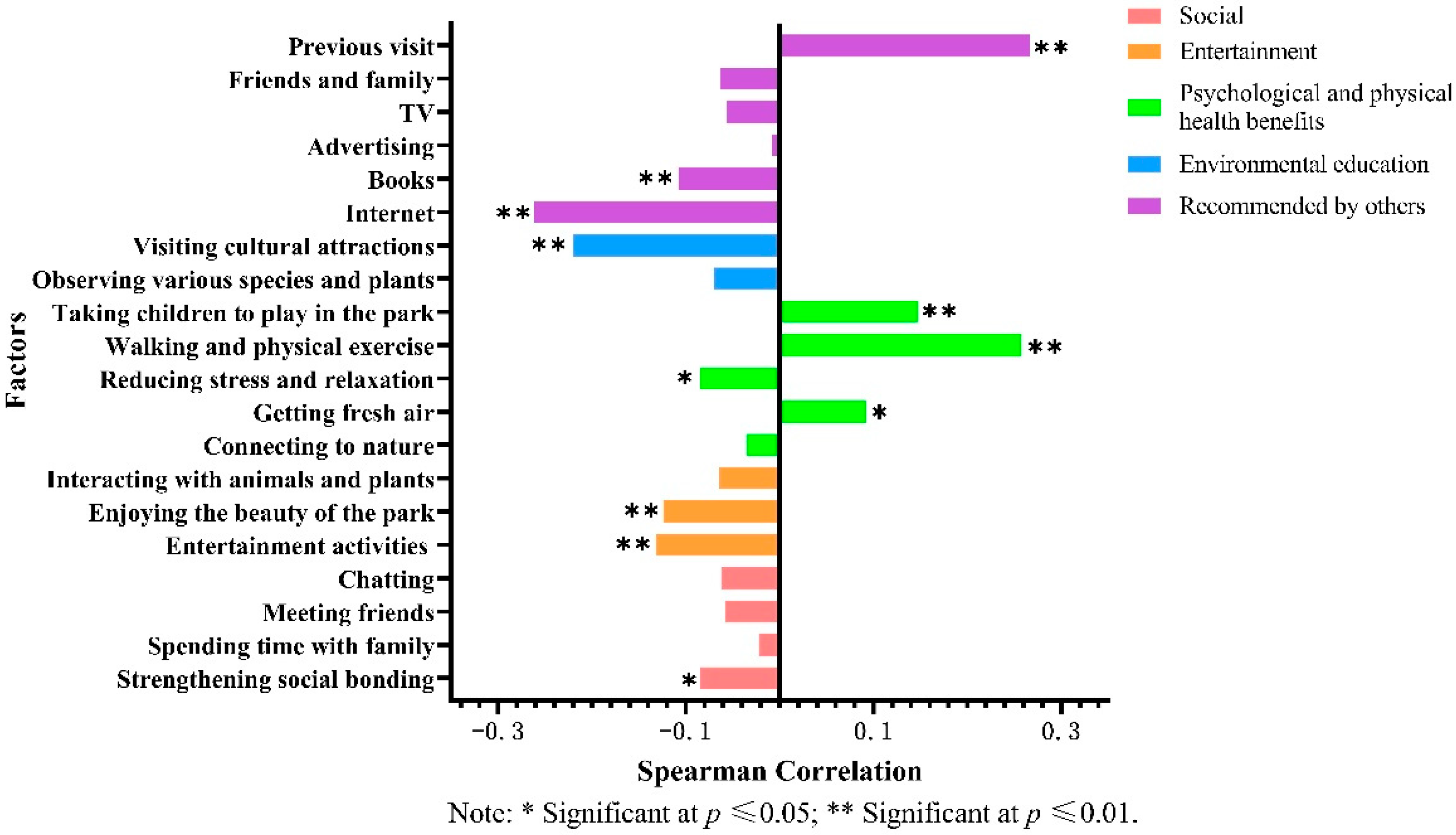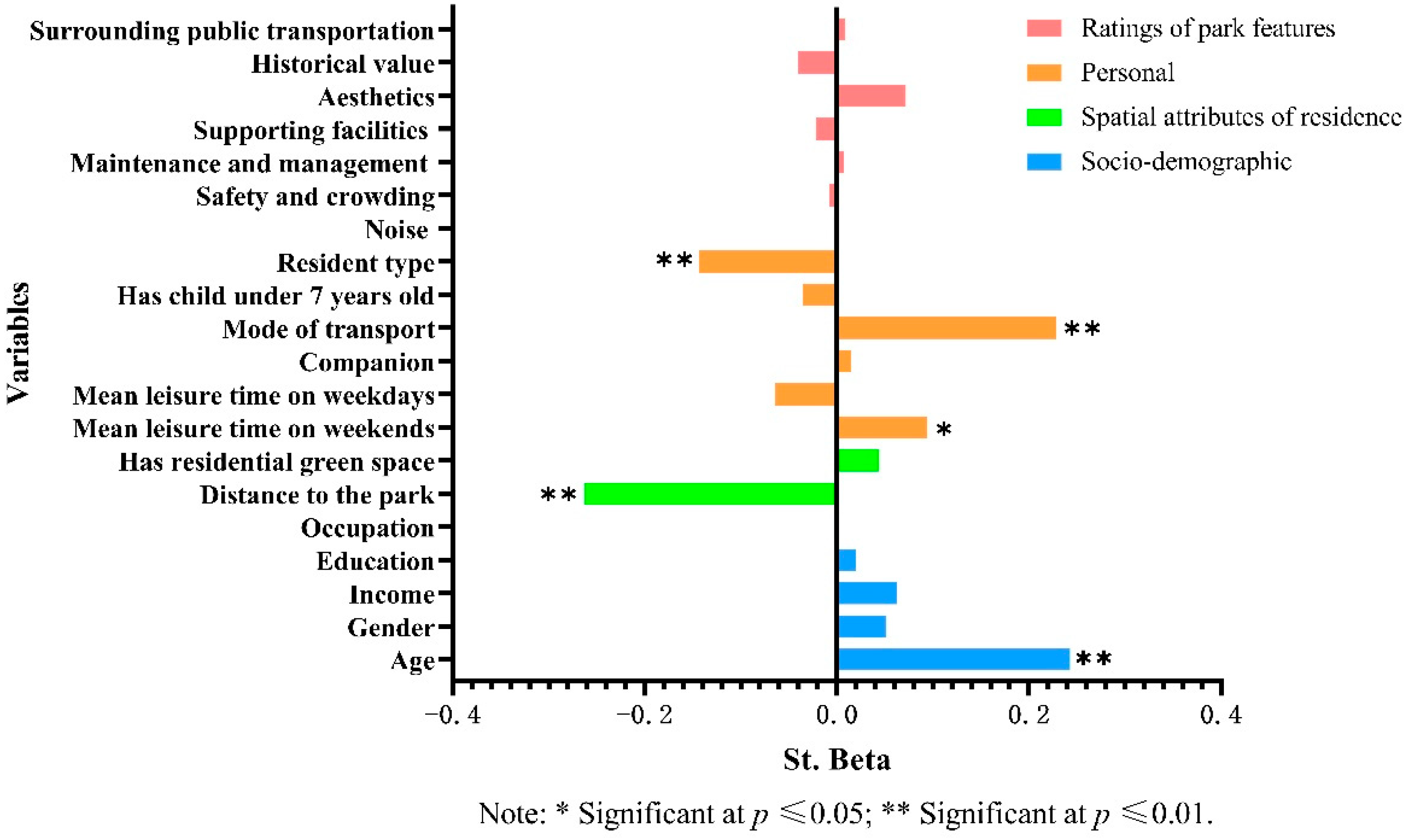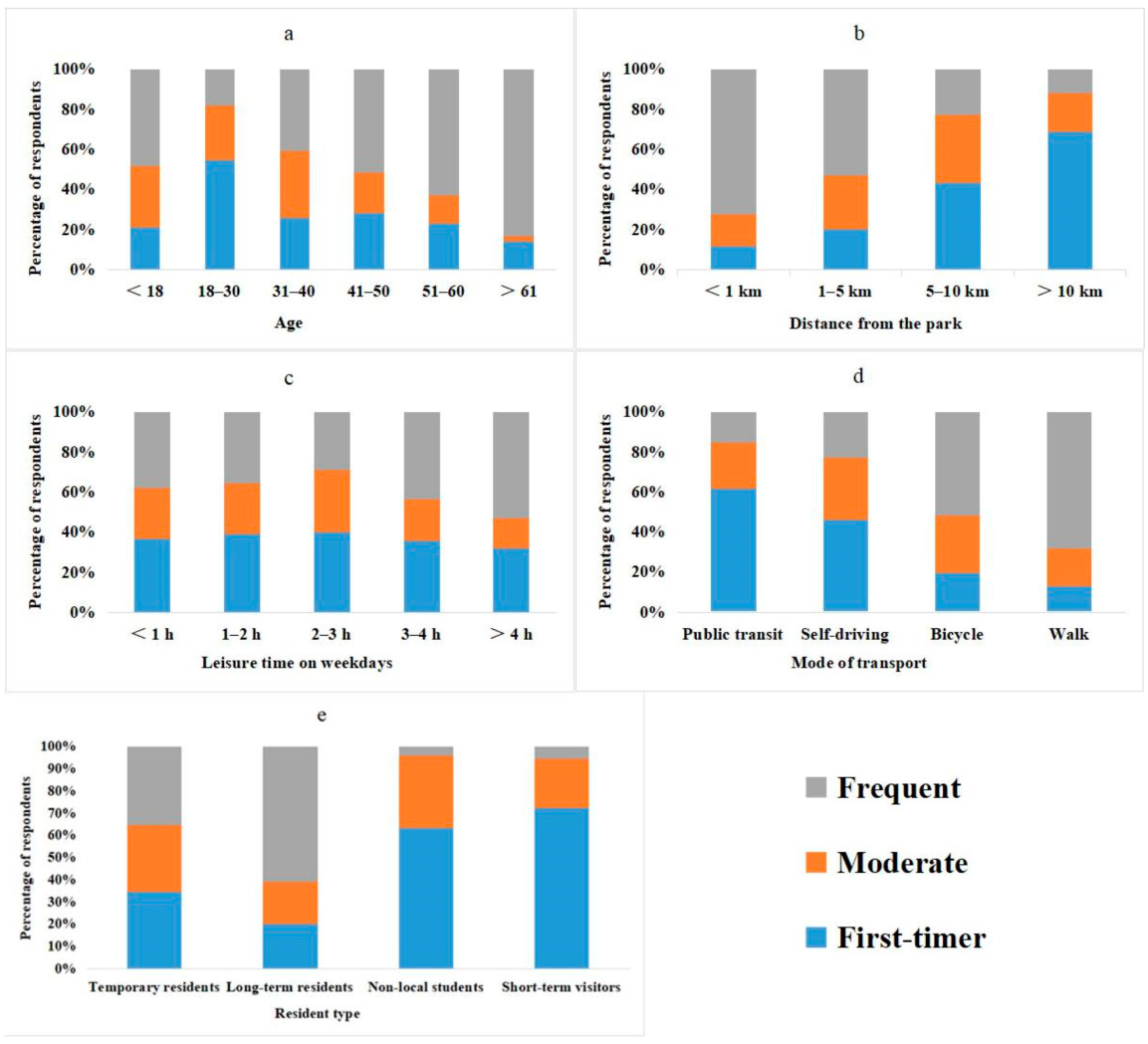Factors Influencing the Visitation and Revisitation of Urban Parks: A Case Study from Hangzhou, China
Abstract
:1. Introduction
2. Materials and Methods
2.1. Study Site
2.2. Experimental Design and Data Collection
2.3. Variables
2.4. Statistical Analysis
3. Results
3.1. Descriptive Statistics
3.2. Motivations for Repeat Visits, Behavioral Preferences, and Factors Limiting Urban Park Visitation
3.3. Statistical Analysis
4. Discussion
4.1. Visitors’ Motivations for First-Time and Repeat Visits to City Parks
4.2. Visitors’ Urban Park Preferences
4.3. Factors Limiting Park Use
4.4. Factors Affecting Visitation and Revisitation to Urban Parks
5. Conclusions
Supplementary Materials
Author Contributions
Funding
Institutional Review Board Statement
Informed Consent Statement
Data Availability Statement
Acknowledgments
Conflicts of Interest
References
- Hartig, T., Jr.; Kahn, P.H. Living in cities, naturally. Science 2016, 352, 938–940. [Google Scholar] [CrossRef]
- Bertram, C.; Rehdanz, K. The role of urban green space for human well-being. Ecol. Econ. 2015, 120, 139–152. [Google Scholar] [CrossRef] [Green Version]
- Knobel, P.; Maneja, R.; Bartoll, X.; Alonso, L.; Bauwelinck, M.; Valentin, A.; Zijlema, W.; Borrell, C.; Nieuwenhuijsen, M.; Dadvand, P. Quality of urban green spaces influences residents’ use of these spaces, physical activity, and overweight/obesity. Environ. Pollut. 2021, 271, 116393. [Google Scholar] [CrossRef] [PubMed]
- Tamosiunas, A.; Grazuleviciene, R.; Luksiene, D.; Dedele, A.; Reklaitiene, R.; Baceviciene, M.; Vencloviene, J.; Bernotiene, G.; Radisauskas, R.; Malinauskiene, V.; et al. Accessibility and use of urban green spaces, and cardiovascular health: Findings from a Kaunas cohort study. Environ. Health BioMed Central 2014, 13, 20. [Google Scholar] [CrossRef] [PubMed] [Green Version]
- Kong, F.; Yin, H.; Nakagoshi, N.; Zong, Y. Urban green space network development for biodiversity conservation: Identification based on graph theory and gravity modeling. Landsc. Urban Plan. 2010, 95, 16–27. [Google Scholar] [CrossRef]
- Zanon, D.; Doucouliagos, C.; Hall, J.; Lockstone-Binney, L. Constraints to park visitation: A meta-analysis of North American studies. Leis. Sci. 2013, 35, 475–493. [Google Scholar] [CrossRef]
- Huang, Y.; Xu, J. Exploring the factors of using frequency of large-scale urban public space: Post-occupancy evaluation of the flower city square and the Pearl River park. S. Archit. 2013, 4, 86–90. [Google Scholar]
- Wang, P.; Zhou, B.; Han, L.; Mei, R. The motivation and factors influencing visits to small urban parks in Shanghai, China. Urban For. Urban Green. 2021, 60, 127086. [Google Scholar] [CrossRef]
- Liu, H.; Li, F.; Xu, L.; Han, B. The impact of socio-demographic, environmental, and individual factors on urban park visitation in Beijing, China. J. Clean. Prod. 2017, 163, S181–S188. [Google Scholar] [CrossRef]
- Gundersen, V.; Mehmetoglu, M.; Vistad, O.I.I.; Andersen, O. Linking visitor motivation with attitude towards management restrictions on use in a national park. J. Outdoor Recreat. Tour. 2015, 9, 77–86. [Google Scholar] [CrossRef] [Green Version]
- Gibson, S.C. “Let’s go to the park.” An investigation of older adults in Australia and their motivations for park visitation. Landsc. Urban Plan. 2018, 180, 234–246. [Google Scholar] [CrossRef]
- Vierikko, K.; Gonçalves, P.; Haase, D.; Elands, B.; Ioja, C.; Jaatsi, M.; Pieniniemi, M.; Lindgren, J.; Grilo, F.; Santos-Reis, M.; et al. Biocultural diversity (BCD) in European cities—Interactions between motivations, experiences and environment in public parks. Urban For. Urban Green. 2020, 48, 126501. [Google Scholar] [CrossRef]
- Dinda, S.; Ghosh, S. Perceived benefits, aesthetic preferences and willingness to pay for visiting urban parks: A case study from the city of Kolkata, India. Int. J. Geoheritage Parks 2021, 9, 36–50. [Google Scholar] [CrossRef]
- Tang, X.; Wang, D.; Sun, Y.; Chen, M.; Waygood, E.O.D. Choice behavior of tourism destination and travel mode: A case study of local residents in Hangzhou, China. J. Transp. Geogr. 2020, 89, 102895. [Google Scholar] [CrossRef]
- Halkos, G.; Leonti, A.; Sardianou, E. Activities, motivations and satisfaction of urban parks visitors: A structural equation modeling analysis. Econ. Anal. Policy 2021, 70, 502–513. [Google Scholar] [CrossRef]
- Fischer, L.K.; Honold, J.; Botzat, A.; Brinkmeyer, D.; Cvejic, R.; Delshammar, T.; Elands, B.; Haase, D.; Kabisch, N.; Karle, S.J.; et al. Recreational ecosystem services in European cities: Sociocultural and geographical contexts matter for park use. Ecosyst. Serv. 2018, 31, 455–467. [Google Scholar] [CrossRef]
- Grilli, G.; Mohan, G.; Curtis, J. Public park attributes, park visits, and associated health status. Landsc. Urban Plan. 2020, 199, 103814. [Google Scholar] [CrossRef]
- Azagew, S.; Worku, H. Socio-demographic and physical factors influencing access to urban parks in rapidly urbanizing cities of Ethiopia: The case of Addis Ababa. J. Outdoor Recreat. Tour. 2020, 31, 100322. [Google Scholar] [CrossRef]
- Zhang, S.; Zhou, W. Recreational visits to urban parks and factors affecting park visits: Evidence from geotagged social media data. Landsc. Urban Plan. 2018, 180, 27–35. [Google Scholar] [CrossRef]
- Liang, H.; Zhang, Q. Temporal and spatial assessment of urban park visits from multiple social media data sets: A case study of Shanghai, China. J. Clean. Prod. 2021, 297, 126682. [Google Scholar] [CrossRef]
- Mu, B.; Liu, C.; Mu, T.; Xu, X.; Tian, G.; Zhang, Y.; Kim, G. Spatiotemporal fluctuations in urban park spatial vitality determined by on-site observation and behavior mapping: A case study of three parks in Zhengzhou City, China. Urban For. Urban Green. 2021, 64, 127246. [Google Scholar] [CrossRef]
- Sun, R.; Li, F.; Chen, L. A demand index for recreational ecosystem services associated with urban parks in Beijing, China. J. Environ. Manag. 2019, 251, 109612. [Google Scholar] [CrossRef] [PubMed]
- Yin, M. Research on Recreation Motivations of City Park Recreationists in Changsha City. Master’s Thesis, Hunan Normal University, Changsha, China, 2008. [Google Scholar]
- Baker, D.A.; Crompton, J.L. Quality, satisfaction and behavioral intentions. Ann. Tourism. Res. 2000, 27, 785–804. [Google Scholar] [CrossRef]
- Chi, C.G.; Qu, H. Examining the structural relationships of destination image, tourist satisfaction and destination loyalty: An integrated approach. Tourism. Manag. 2008, 29, 624–636. [Google Scholar] [CrossRef]
- Schofield, P.; Thompson, K. Visitor motivation, satisfaction and behavioural intention: The 2005 Naadam Festival, Ulaanbaatar. Int. J. Tour. Res. 2007, 9, 329–344. [Google Scholar] [CrossRef]
- Darnell, A.C.; Johnson, P.S. Repeat visits to attractions: A preliminary economic analysis. Tourism. Manag. 2001, 22, 119–126. [Google Scholar] [CrossRef]
- Kozak, M. Repeaters’ behavior at two distinct destinations. Ann. Tourism. Res. 2001, 28, 784–807. [Google Scholar] [CrossRef]
- Shi, Y. Research on the Characteristics and Influencing Factors of Tourists’revisiting Behavior in Ulanbutong Gramsland Tourism Destination. Master’s Thesis, Inner Mongolia NormalUniversity, Hohhot, China, 2020. [Google Scholar]
- Choe, Y.; Schuett, M.A.; Sim, K. An analysis of first-time and repeat visitors to Korean national parks from 2007 and 2013. J. Mt. Sci. 2017, 14, 2527–2539. [Google Scholar] [CrossRef]
- Assaker, G.; Vinzi, V.E.; O’Connor, P. Examining the effect of novelty seeking, satisfaction, and destination image on tourists’ return pattern: A two factor, non-linear latent growth model. Tourism. Manag. 2011, 32, 890–901. [Google Scholar] [CrossRef]
- Kruger, M.; Saayman, M.; Hermann, U.P. First-time versus repeat visitors at the Kruger National Park. Acta Commer. 2014, 14, 1–9. [Google Scholar] [CrossRef] [Green Version]
- Shapoval, V.; Rivera, M.; Croes, R. The quality of gardens tourism and the visitor experience: Differentiating between first time and repeat visitors. Ann. Leis. Res. 2020, in press. [Google Scholar] [CrossRef]
- Li, X.; Cheng, C.; Kim, H.; Petrick, J.F. A systematic comparison of first-time and repeat visitors via a two-phase online survey. Tourism Manag. 2008, 29, 278–293. [Google Scholar] [CrossRef]
- Lau, A.L.S.; McKercher, B. Exploration Versus acquisition: A comparison of first-time and repeat visitors. J. Travel Res. 2004, 42, 279–285. [Google Scholar] [CrossRef]
- Chen, Y.; Xu, Z.; Byrne, J.; Xu, T.; Wang, S.; Wu, J. Can smaller parks limit green gentrification? Insights from Hangzhou, China. Urban For. Urban Green. 2021, 59, 127009. [Google Scholar] [CrossRef]
- Hangzhou Bureau of Statistics. 2020 Hangzhou Statistical Yearbook. 2020. Available online: http://tjj.hangzhou.gov.cn/art/2020/10/29/art_1229453592_3819709.html (accessed on 3 July 2021).
- Song, X.P.; Richards, D.R.; He, P.; Tan, P.Y. Does geo-located social media reflect the visit frequency of urban parks? A city-wide analysis using the count and content of photographs. Landsc. Urban Plan. 2020, 203, 103908. [Google Scholar] [CrossRef]
- Lv, M.; Jin, H.; Wang, Y. Effects of Small-scale Waters in Urban Parks on Summer Microclimate: A Case Study of Prince Bay Park in Hangzhou. J. Chin. Urban For. 2019, 17, 18–24. [Google Scholar]
- Zhang, J. Satisfaction Evaluation of Hangzhou City Park Recreation Based on Logistic Analysis. Master’s Thesis, Zhejiang Agriculture and Forestry University, Hangzhou, China, 2020. [Google Scholar]
- Yang, J. The heterogeneous preferences for conservation and management in urban wetland parks: A case study from China. Urban For. Urban Green. 2021, 60, 127064. [Google Scholar] [CrossRef]
- Hangzhou Bureau of Planning and Natural Resources. The Land and Space Master Plan of Hangzhou (2001–2020). 2019. Available online: http://ghzy.hangzhou.gov.cn/art/2019/10/31/art_1228962781_39671549.html (accessed on 3 July 2021).
- Li, Z.; Wei, H.; Wu, Y.; Su, S.; Wang, W.; Qu, C. Impact of community deprivation on urban park access over time: Understanding the relative role of contributors for urban planning. Habitat Int. 2019, 92, 102031. [Google Scholar] [CrossRef]
- The People’ s Government of Zhejiang Province. Zhejiang Provincial People’s Government on the Adjustment of Some of the Administrative Divisions of Hangzhou City Notice. 2021. Available online: http://www.zj.gov.cn/art/2021/4/9/art_1229019364_2267333.html (accessed on 3 July 2021).
- Mak, B.K.L.; Jim, C.Y. Linking park users’ socio-demographic characteristics and visit-related preferences to improve urban parks. Cities 2019, 92, 97–111. [Google Scholar] [CrossRef]
- Guan, C.; Song, J.; Keith, M.; Zhang, B.; Akiyama, Y.; Da, L.; Shibasaki, R.; Sato, T. Seasonal variations of park visitor volume and park service area in Tokyo: A mixed-method approach combining big data and field observations. Urban For. Urban Green. 2021, 58, 126973. [Google Scholar] [CrossRef]
- George, D. Data Analysis for Psychology; Hodder Arnold Publishers: London, UK, 1997. [Google Scholar]
- Sreetheran, M. Exploring the urban park use, preference and behaviours among the residents of Kuala Lumpur, Malaysia. Urban For. Urban Green. 2017, 25, 85–93. [Google Scholar] [CrossRef]
- Shan, X. Socio-demographic variation in motives for visiting urban green spaces in a large Chinese city. Habitat Int. 2014, 41, 114–120. [Google Scholar] [CrossRef]
- Typaldos, M.; Sockrider, M. Delayed sleep phase syndrome. Am. J. Resp. Crit. Care 2019, 200, P7–P8. [Google Scholar] [CrossRef] [PubMed]
- Wang, F.; Tang, M. China’s soccer field development status and countermeasures. Sports Cult. Guide 2017, 8, 109–114. [Google Scholar]
- Tu, X.; Huang, G.; Wu, J.; Guo, X. How Do Travel Distance and Park Size Influence Urban Park Visits? Urban For. Urban Green. 2020, 52, 126689. [Google Scholar] [CrossRef]
- Yang, H. Research on Urban Green Spaces Landscape of Hangzhou. Master’s Thesis, Zhejiang University, Hangzhou, China, 2006. [Google Scholar]




| No. | Urban Park | Types | Area | Park Description |
|---|---|---|---|---|
| 1 | Xixi National Wetland Park | Wetland park | 1150 ha | This park is rich in ecological resources; 70% of it is covered by rivers, ponds, lakes, and marshes. It has many architectural sites, as well as a full range of tourist facilities such as commercial markets, boutique hotels, and restaurants. |
| 2 | Taiziwan Park | Ornamental horticulture park | 80.03 ha | This park is located in the southwest corner of the West Lake Scenic Area. The entire park is traversed by paths and waterways, and it has a large spacious lawn and service buildings for playing and resting. It has an abundance of Japanese Tokyo cherry trees and tulips. It is now a famous wedding venue and tulip exhibition site. |
| 3 | Chengdong Park | Ornamental horticulture park | 10.66 ha | There are numerous residential areas surrounding this park. The park has swimming pools, tennis courts, and other sports fields. Pavilions, plazas, and spaces under viaducts provide numerous activity areas. Shady greenery and vegetation provide a natural habitat for many bird and insect species. |
| 4 | Hangzhou Chengbei Sports Park | Sports park | 45.73 ha | This park has three sports halls, several basketball courts, soccer fields, tennis courts, and other sports fields, as well as abundant greenery and lawns. |
| 5 | Jinsha Lake Park | Waterscape park | 64.6 ha | This park has the largest artificial lake in Hangzhou, which is lined with two rows of palm trees and a beach, rendering a seaside atmosphere. The park’s garden has various forest paths and is suitable for fitness, walking, and as a wedding venue. |
| 6 | Qianjiang Century Park | Waterscape park | 62 ha | This park is located on the south bank of Qiantang River, adjacent to Hangzhou Olympic Sports Center and was the main venue of the G20 Summit. There is a large lawn along the river with a fountain feature, as well as a dedicated dining area and business office area. |
| Statistics | Model 1 (Socio-Demographic Variables) | Model 2 (Model 1+Spatial Attributes of Residence) | Model 3 (Model 2+Personal Variables) | Model 4 (Model 3+Park FeaTure Variables) |
|---|---|---|---|---|
| F value | 25.179 | 46.124 | 32.223 | 20.97 |
| Significance | <0.001 | <0.001 | <0.001 | <0.001 |
| df | 579 | 577 | 571 | 564 |
| R2 | 0.179 | 0.359 | 0.423 | 0.426 |
| Adj R2 | 0.172 | 0.351 | 0.41 | 0.406 |
| ΔAdj R2 | 0.18 | 0.064 | −0.003 |
Publisher’s Note: MDPI stays neutral with regard to jurisdictional claims in published maps and institutional affiliations. |
© 2021 by the authors. Licensee MDPI, Basel, Switzerland. This article is an open access article distributed under the terms and conditions of the Creative Commons Attribution (CC BY) license (https://creativecommons.org/licenses/by/4.0/).
Share and Cite
Zhan, P.; Hu, G.; Han, R.; Kang, Y. Factors Influencing the Visitation and Revisitation of Urban Parks: A Case Study from Hangzhou, China. Sustainability 2021, 13, 10450. https://doi.org/10.3390/su131810450
Zhan P, Hu G, Han R, Kang Y. Factors Influencing the Visitation and Revisitation of Urban Parks: A Case Study from Hangzhou, China. Sustainability. 2021; 13(18):10450. https://doi.org/10.3390/su131810450
Chicago/Turabian StyleZhan, Peng, Guang Hu, Ruilian Han, and Yu Kang. 2021. "Factors Influencing the Visitation and Revisitation of Urban Parks: A Case Study from Hangzhou, China" Sustainability 13, no. 18: 10450. https://doi.org/10.3390/su131810450
APA StyleZhan, P., Hu, G., Han, R., & Kang, Y. (2021). Factors Influencing the Visitation and Revisitation of Urban Parks: A Case Study from Hangzhou, China. Sustainability, 13(18), 10450. https://doi.org/10.3390/su131810450






